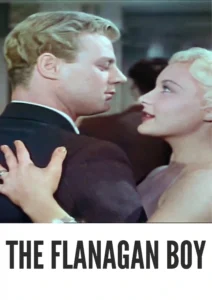Contact: [email protected]
Video Sources 0 Views
- Watch trailer
- The Flanagan Boy


The Flanagan Boy 1953 First Early Colored Films Version
Synopsis
Table of Contents
ToggleReview: The Flanagan Boy 1953 – Navigating the Impact of Early Colorization

Introduction
The Flanagan Boy holds a unique place in cinematic history as a British crime drama released in 1953. Directed by Reginald Le Borg, this film has garnered attention for its exploration of themes like identity, family, and the allure of the criminal underworld. In this review, we’ll delve into the intriguing narrative of The Flanagan Boy 1953 and examine how its early colorization affects the viewing experience, offering fresh insights into this lesser-known gem.
Check The Full Colorized Movies List
Check Our Colorized Movies Trailer Channel
Understanding The Flanagan Boy 1953: Director, Cast, and Genre
Directed by Reginald Le Borg, The Flanagan Boy 1953 follows the story of Johnny Flanagan, played by Tony Wright, a young man caught between two worlds: his criminal past and his desire for redemption. With standout performances from actors such as Barbara Murray and Sean Sullivan, the film blends elements of crime, drama, and romance to create a compelling narrative that resonates with audiences.
Exploring the World of The Flanagan Boy 1953: Plot and Characters
Set in the gritty streets of post-war London, The Flanagan Boy 1953 follows Johnny Flanagan’s journey as he tries to leave behind his criminal past and make a fresh start. However, his efforts are complicated by his involvement with a dangerous gang and his budding romance with Anne, a young woman who sees the good in him despite his troubled past. As Johnny grapples with his conflicting desires, he must confront the choices that have brought him to this crossroads and decide what kind of man he wants to be.
The Art of Film Colorization
Film colorization has long been a controversial topic in the world of cinema. While some see it as a way to breathe new life into classic films and make them more accessible to modern audiences, others argue that it detracts from the artistic integrity of the original work. Regardless of where one stands on the issue, early colorization techniques offer a fascinating glimpse into the evolving landscape of film preservation and restoration.
Early Colored Films: A Brief History
The history of early colored films is as varied as the colors themselves. From hand-painted frames to early color processes like Technicolor, filmmakers have long experimented with ways to bring vibrant hues to the silver screen. While these early techniques may seem primitive by today’s standards, they laid the groundwork for the stunning visual effects and digital wizardry that define modern cinema.
The Flanagan Boy 1953 and Its Early Colored Version
The decision to release The Flanagan Boy 1953 in a colorized format was met with both excitement and skepticism. While some saw it as an opportunity to breathe new life into a lesser-known classic, others worried that it would detract from the film’s gritty atmosphere and noir-inspired aesthetic. Ultimately, whether one prefers the original black and white version or the colorized edition is a matter of personal preference. However, the colorized version offers a fresh perspective on The Flanagan Boy 1953, allowing audiences to see familiar scenes in a new light and perhaps discover new depths to the film’s visual and emotional impact.
The Debate Over Film Colorization
The debate over film colorization continues to rage on, with proponents praising its ability to make classic films more accessible to modern audiences and opponents arguing that it compromises the artistic integrity of the original work. While there may never be a clear consensus on the issue, one thing is certain: early colorization techniques offer a fascinating glimpse into the evolving landscape of film preservation and restoration.
Examining The Flanagan Boy 1953 as an Early Colored Film
Viewing The Flanagan Boy 1953 in its early colorized iteration offers a unique viewing experience. While the colorization adds a layer of visual richness to the film, some may argue that it detracts from the gritty realism and noir-inspired aesthetic of the original black and white version. However, others may appreciate the opportunity to see familiar scenes in a new light, with vibrant colors enhancing the film’s visual and emotional impact. Ultimately, whether one prefers the original black and white version or the colorized edition is a matter of personal preference.
Influence and Legacy: The Flanagan Boy 1953’s Impact on Cinema
The Flanagan Boy 1953 may not be as well-known as some of its contemporaries, but its impact on British cinema is undeniable. With its compelling narrative, standout performances, and timeless themes, the film has earned its place in the annals of cinematic history, inspiring filmmakers and audiences alike for generations to come.
Director’s Cinematic Legacy: Beyond The Flanagan Boy 1953
Reginald Le Borg’s directorial legacy extends far beyond The Flanagan Boy 1953. Throughout his career, he pushed the boundaries of conventional filmmaking, tackling a wide range of genres and subjects with equal aplomb. His bold storytelling and keen eye for detail have left an indelible mark on the world of cinema, influencing countless filmmakers and captivating audiences around the globe.
Themes Explored in The Flanagan Boy 1953
At its core, The Flanagan Boy 1953 explores themes of identity, redemption, and the search for meaning in a world filled with uncertainty. Through its compelling narrative and richly drawn characters, the film offers a thought-provoking meditation on the human condition and the choices that define us.
Reception and Controversy Surrounding The Flanagan Boy 1953
The release of the colorized version of The Flanagan Boy 1953 sparked a flurry of debate among critics and audiences alike. While some praised the film’s newfound visual splendor, others lamented the loss of its gritty noir aesthetic. Despite the controversy, the film remains a compelling testament to the power of storytelling and the enduring appeal of classic cinema.
Where to Watch The Flanagan Boy 1953 Online
For those eager to experience The Flanagan Boy 1953 for themselves, the film is readily available on popular streaming platforms such as Netflix, Amazon Prime, and Hulu. Whether viewed in its original black and white format or its early colorized iteration, The Flanagan Boy 1953 continues to captivate audiences with its compelling narrative and richly drawn characters, cementing its status as a true classic of British cinema.
FAQs About The Flanagan Boy 1953
1. Is The Flanagan Boy 1953 based on a true story?
The Flanagan Boy 1953 is a work of fiction inspired by real-life events and experiences. While the film’s storyline is not directly based on a specific true story, it draws inspiration from the gritty realities of post-war London and the allure of the criminal underworld to craft its compelling narrative.
2. Who directed The Flanagan Boy 1953?
The Flanagan Boy 1953 was directed by Reginald Le Borg, a versatile filmmaker known for his ability to tackle a wide range of genres and subjects with equal aplomb. Le Borg’s keen eye for detail and bold storytelling elevate The Flanagan Boy 1953 to cinematic greatness, making it a standout example of his directorial prowess.
3. What is the central conflict of The Flanagan Boy 1953?
At its core, The Flanagan Boy 1953 revolves around the central conflict between Johnny Flanagan’s desire for redemption and his involvement with a dangerous criminal gang. As he grapples with his conflicting desires and the choices that have brought him to this crossroads, he must confront the demons of his past and decide what kind of man he wants to be.
4. What sets The Flanagan Boy 1953 apart from other crime dramas of its time?
The Flanagan Boy 1953 stands out from other crime dramas of its time due to its compelling narrative, richly drawn characters, and atmospheric setting. Director Reginald Le Borg’s keen eye for detail and bold storytelling elevate the film to cinematic greatness, making it a standout example of British noir cinema.
5. What is the significance of the film’s early colorized version?
The early colorized version of The Flanagan Boy 1953 offers audiences a fresh perspective on a classic crime drama, allowing them to see familiar scenes in a new light. While some purists may prefer the original black and white version, the colorized edition provides an opportunity to experience the film’s gritty atmosphere and richly drawn characters in a new way, with vibrant colors enhancing the visual and emotional impact of the story.
6. How does the colorization process affect the film’s visual aesthetic?
The colorization process adds a layer of visual richness to The Flanagan Boy 1953, enhancing the film’s overall visual appeal. However, some purists argue that it detracts from the gritty noir aesthetic of the original black and white version. Ultimately, whether one prefers the original black and white version or the colorized edition is a matter of personal preference.
7. What is the legacy of The Flanagan Boy 1953?
The Flanagan Boy 1953 may not be as well-known as some of its contemporaries, but its impact on British cinema is undeniable. With its compelling narrative, standout performances, and timeless themes, the film has earned its place in the annals of cinematic history, inspiring filmmakers and audiences alike for generations to come.
8. Are there any sequels or remakes of The Flanagan Boy 1953?
While there are no direct sequels or remakes of The Flanagan Boy 1953, the film has inspired numerous works of art across various mediums, including literature, television, and music. Its influence can be seen in everything from gritty crime dramas to thought-provoking character studies, cementing its status as a true classic of British cinema.
9. Where can I watch The Flanagan Boy 1953 online?
For those eager to experience The Flanagan Boy 1953 for themselves, the film is readily available on popular streaming platforms such as Netflix, Amazon Prime, and Hulu. Whether viewed in its original black and white format or its early colorized iteration, The Flanagan Boy 1953 continues to captivate audiences with its compelling narrative and richly drawn characters, cementing its status as a true classic of British cinema.
Conclusion
In conclusion, The Flanagan Boy 1953 remains a captivating classic of British cinema, regardless of its colorized iteration. While the debate over film colorization continues to rage on, one thing remains clear: Reginald Le Borg’s bold direction and compelling storytelling elevate The Flanagan Boy 1953 to cinematic greatness. Whether viewed in its original black and white format or its early colorized version, the film continues to captivate audiences with its gripping narrative and richly drawn characters, leaving a lasting impression that transcends time and space. As audiences continue to revisit this cinematic gem for generations to come, its legacy will endure, inspiring countless filmmakers and captivating audiences with its timeless exploration of identity, redemption, and the human condition. Ultimately, the choice of whether to watch The Flanagan Boy 1953 in black and white or colorized format is a matter of personal preference. However, what remains undeniable is the film’s ability to enthrall and engage audiences, making it a true classic of British cinema.








